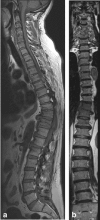Incidence of numerical variants and transitional lumbosacral vertebrae on whole-spine MRI
- PMID: 26873359
- PMCID: PMC4805617
- DOI: 10.1007/s13244-016-0468-7
Incidence of numerical variants and transitional lumbosacral vertebrae on whole-spine MRI
Abstract
Objectives: This study sets out to prospectively investigate the incidence of transitional vertebrae and numerical variants of the spine.
Materials and methods: Over a period of 28 months, MRIs of the whole spine were prospectively evaluated for the presence of transitional lumbosacral vertebrae and numerical variants of the spine.
Results: MRI of the whole spine was evaluated in 420 patients, comprising 211 female and 209 male subjects. Two patients had more complex anomalies. Lumbosacral transitional vertebrae were seen in 12 patients: eight sacralised L5 (3 male, 5 female) and four lumbarised S1 (3 male, 1 female). The incidence of transitional vertebrae was approximately 3.3. % (14/418). Thirty-two (7.7 %) of 418 patients had numerical variants of mobile vertebrae of the spine without transitional vertebrae. The number of mobile vertebrae was increased by one in 18 patients (12 male, 6 female), and the number was decreased by one in 14 patients (4 male, 10 female).
Conclusions: Numerical variants of the spine are common, and were found to be almost 2.5 times as frequent as transitional lumbosacral vertebrae in the study population. Only whole-spine imaging can identify numerical variants and the anatomical nature of transitional vertebrae. The tendency is toward an increased number of mobile vertebrae in men and a decreased number in women. Main messages • Numerical variants of the spine are more common than transitional vertebrae. • Spinal numerical variants can be reliably identified only with whole-spine imaging. • Increased numbers of vertebrae are more common in men than women. • Transitional lumbosacral vertebrae occurred in about 3.3 % of the study population. • The incidence of numerical variants of the spine was about 7.7 %.
Keywords: Incidence; Lumbar vertebrae; MRI; Spine.
Figures




Similar articles
-
Lumbosacral Transitional Vertebrae amongst the Individuals Undergoing Magnetic Resonance Imaging of the Whole Spine in a Tertiary Care Hospital: A Descriptive Cross-sectional Study.JNMA J Nepal Med Assoc. 2021 Oct 15;59(242):975-978. doi: 10.31729/jnma.6336. JNMA J Nepal Med Assoc. 2021. PMID: 35199704 Free PMC article.
-
Lumbosacral Transitional Vertebrae Cause Spinal Level Misconception in Surgeries for Degenerative Lumbar Spine Disorders.Tohoku J Exp Med. 2017 Jul;242(3):223-228. doi: 10.1620/tjem.242.223. Tohoku J Exp Med. 2017. PMID: 28717058
-
Associations between lumbosacral transitional anatomy types and degeneration at the transitional and adjacent segments.Spine J. 2015 Jun 1;15(6):1210-6. doi: 10.1016/j.spinee.2013.10.029. Epub 2013 Nov 8. Spine J. 2015. PMID: 24216396
-
A review of lumbosacral transitional vertebrae and associated vertebral numeration.Eur Spine J. 2018 May;27(5):995-1004. doi: 10.1007/s00586-018-5554-8. Epub 2018 Mar 21. Eur Spine J. 2018. PMID: 29564611 Review.
-
Lumbosacral Transitional Segments: An Interventional Spine Specialist's Practical Approach.Phys Med Rehabil Clin N Am. 2018 Feb;29(1):35-48. doi: 10.1016/j.pmr.2017.08.004. Phys Med Rehabil Clin N Am. 2018. PMID: 29173663 Review.
Cited by
-
Regulation of posterior Hox genes by sex steroids explains vertebral variation in inbred mouse strains.J Anat. 2022 Apr;240(4):735-745. doi: 10.1111/joa.13580. Epub 2021 Nov 7. J Anat. 2022. PMID: 34747015 Free PMC article. Review.
-
Extra-articular Portion of the Sacroiliac Joint-Between the Sacral and Pelvic Tuberosities: An Anatomical Guide for the S2-Alar-Iliac Screw Trajectory.Global Spine J. 2021 Apr;11(3):305-311. doi: 10.1177/2192568220903033. Epub 2020 Feb 3. Global Spine J. 2021. PMID: 32875863 Free PMC article.
-
Lumbosacral transitional vertebrae: significance of local bone marrow edema at the transverse processes.Skeletal Radiol. 2018 Aug;47(8):1145-1149. doi: 10.1007/s00256-018-2900-1. Epub 2018 Feb 16. Skeletal Radiol. 2018. PMID: 29453618
-
Association of spinal anomalies with spondylolysis and spina bifida occulta.Eur Spine J. 2022 Apr;31(4):858-864. doi: 10.1007/s00586-022-07139-5. Epub 2022 Mar 2. Eur Spine J. 2022. PMID: 35237865
-
A computed tomography vertebral segmentation dataset with anatomical variations and multi-vendor scanner data.Sci Data. 2021 Oct 28;8(1):284. doi: 10.1038/s41597-021-01060-0. Sci Data. 2021. PMID: 34711848 Free PMC article.
References
-
- Delport EG, et al. Lumbosacral transitional vertebrae: incidence in a consecutive patient series. Pain Physician. 2006;9(1):53–6. - PubMed
LinkOut - more resources
Full Text Sources
Other Literature Sources

